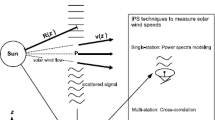Abstract
From the end of July 1975 until August 1976 the reception of signals from the geostationary satellite ATS-6was possible since at that time the satellite was brought into a position above Victoria Lake at 35° East. The copolar signal showed attenuation which varies strongly with the amount of rain. The rain was measured by a rain gauge located close to the 3 meter precision Cassegrain antenna. The attenuation measured at the satellite link did not always correspond with the attenuation measured at the nearby line of sight link at 34 GHz. For example during heavy thunderstorms the attenuation might have reach values as high as 20 dB or more. For smaller attenuations comparison is possible with a radiometer experiment at 30.1 GHz. In general this comparison shows good results for attenuations less than 10 dB. The crosspolar signal measured showed values of — 55 dB to about — 20 dB relative to the copolar depending upon several reasons. First of all the rain showed mostly a strong increase in the crosspolar signal but satellite movements and errors in the antenna pointing will also increased this level. Various examples are shown. It appears that the copolar — cross-polar isolation reached the lowest value at attenuations of 3–6 dB. Although the time that the satellite was available for measurements was limited, some statistic results can be given despite the fact the signal transmitted from the satellite was not always constant.
Analyse
De fin juillet 1975 à août 1976, il a été possible de recevoir les signaux du satellite géostationnaire ATS-6puisque, pendant cette période, le satellite était situé audessus du lac Victoria, à 35° est. Le signal reçu en polarisation parallèle montre un affaiblissement qui varie fortement avec la quantité de pluie. La pluie est mesurée par un pluviomètre situé près de l’antenne Cassegrain de précision de 3 m de diamètre. L’affaiblissement mesuré sur le trajet satelliteterre ne correspond pas toujours à l’affaiblissement mesuré à 34 GHz sur les faisceaux hertziens proches. Un exemple en est donné, durant de fortes pluies, l’affaiblissement peut atteindre des valeurs de 20 dB ou plus. Pour les plus faibles affaiblissements, la comparaison est possible avec un radiomètre expérimental fonctionnant à 30 GHz. En général, cette comparaison montre de bons résultats pour des affaiblissements inférieurs à 10 dB. Le signal en polarisation croisée a des valeurs de — 55 à — 20 dB environ par rapport au signal copolaire, et ceci dépend de différentes raisons. En premier lieu, la place augmente beaucoup le signal en polarisation croisée, mais les mouvements du satellite et les erreurs de pointage de l’antenne augmentent également ce niveau. On donne plusieurs exemples. Il apparaît que l’isolation entre polarisations croisées atteint des valeurs aussi faibles que — 3 à — 6 dB. Bien que la période pendant laquelle le satellite fut disponible pour faire des mesures fût courte et que le signal émis ne fût pas constant, on peut cependant donner quelques résultats statistiques.
Similar content being viewed by others
References
Dijk (J.),Jeuken (M.),Mäanders (E. J.) Antenna noise temperature.Proc. Instn. electr. Engrs, G. B. (oct. 1968), 115, n∘ 10, pp. 1 403–1 410.
Dijk (J.),Groothuis (H. H. H.),Mäanders (E. J.). Some improvements in the antenna noise temperature calculation.I.E.E.E. Trans. AP, U. S. A. (sep. 1970),18, n∘ 5, pp. 690–692.
Hogg (D. C.),Chu (T. S.). The role of rain in satellite communications.Proc. I.E.E.E., U. S. A. (sep. 1975),63, n∘ 9, pp. 1 308–1 331.
Evans (B. G.),Thompson (P. T.). Use of cancellation techniques in the measurement of atmospheric crosspolarization.Electron. Letters, G. B. (sep. 1973),9, n∘ 19, pp. 447–448.
***. Radiometeorological data (Données météorologiques). Rapport 563,C.C.I.R., Assemblée pléntère, Genève, 1974, vol. V (1975), pp. 96–112.
Ippolito (L. J.). ATS-6: millimeter wave propagation and communication experiments at 20 and 30 GHz.I.E.E.E. Trans. AES, U. S. A. (nov. 1975),11, n∘ 6, pp. 1 067–1 083.
Stutzman (W. L.),Bostian (C. W.),Manus (E. A.)et al. ATS-6 satellite 20 GHz propagation measurements: at low elevation angles.Electron. Letters, G. B. (dec. 1975),11, n∘ 25-26, pp. 635–636.
Bostian (C. W.),Stutzman (W. L.),Manus (E. A.)et al. Depolarisation measurements on the ats-6 20 GHz down link.I.E.E.E. Trans. MTT, U. S. A. (dec. 1975),23, n∘ 12, pp. 1 049–1 053.
Medhurst (R. G.). Rainfall attenuation of centimeter waves: comparison of theory and measurement.I.E.E.E. Trans. AP, U. S. A. (juil. 1965),13, n∘ 4, pp. 550–564.
Dijk (J.), Maanders (E. J.)et al. ats-6 satellite experiments at Eindhoven University. TH Report to be published in 1977.
Author information
Authors and Affiliations
Rights and permissions
About this article
Cite this article
Dijk, J., Maanders, E.J. Copolar and cross-polar signals received at 30 GHz from ATS-6. Ann. Télécommunic. 32, 502–507 (1977). https://doi.org/10.1007/BF03003503
Received:
Issue Date:
DOI: https://doi.org/10.1007/BF03003503




